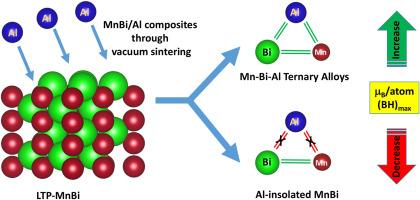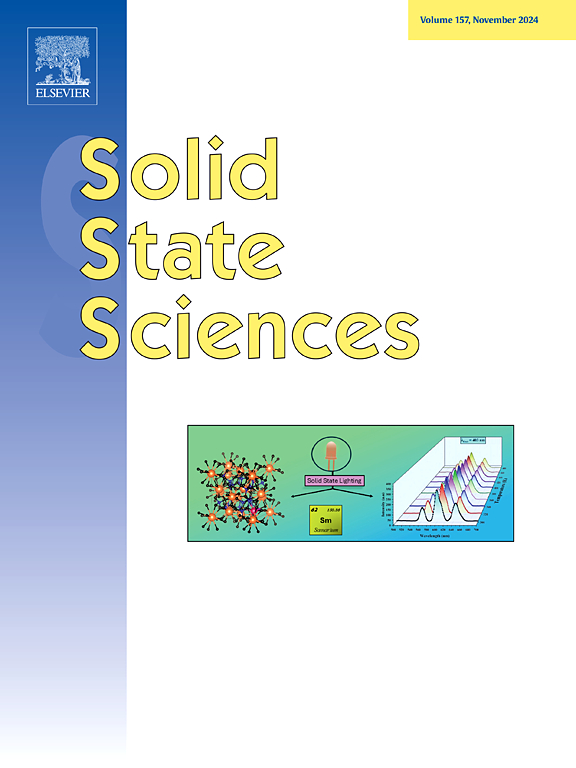锰-铋-铝复合材料中磁性能增强的锰-铋-铝三元合金的形成与表征
IF 3.4
3区 化学
Q2 CHEMISTRY, INORGANIC & NUCLEAR
引用次数: 0
摘要
在 300 °C真空条件下,采用一种潜在的简便、可扩展的低温液相烧结方法合成了低温相锰铋(LTP-MnBi)和一系列铝(Al)复合材料。掺入高达 10% 的铝可显著提高矫顽力(Hc),从 2.32 ± 0.04 kOe 提高到 4.15 ± 0.07 kOe,而饱和磁化率则略有下降,降幅小于 3%。然而,超过这一浓度后,Hc 会急剧下降。新压制粉末的密度(铝含量高达 10%)相对稳定,保持在 7.47-7.58 g/cm³,但随着铝过量而降低。新鲜样品的最大能积 (BH)max 为 1 MGOe,含 5% Al 的锰铋复合材料的最大能积 (BH)max 提高了 16%。扫描电子显微镜显示出明显的锰铋和铋富集区,而当铝浓度超过 10% 时,铝富集区变得突出。能量色散光谱证实,只有 3-5% 的铝能有效地融入锰铋区域,多余的铝不均匀地分布在表面。X 射线光电子能谱显示形成了 Al、Al₂O₃ 和潜在的锰-铋-铝三元合金。此外,AlMn/MnBi 等板坯-DFT 模型表明,铝的加入增强了锰铋复合材料中的磁化,为了解铝对锰铋系统磁性能的影响提供了见解。这些发现为解决锰铋结构中过量铋带来的挑战提供了有前途的策略,有可能优化类似非磁性或软磁复合材料系统的磁性能。本文章由计算机程序翻译,如有差异,请以英文原文为准。

Formation and characterization of Mn-Bi-Al ternary alloys of enhanced magnetic performance in MnBi/Al composites
Low-temperature phase manganese bismuth (LTP-MnBi) and a series of aluminum (Al) composites were synthesized using a potentially facile and scalable low-temperature liquid-phase sintering method in a vacuum at 300 °C. The incorporation of up to 10 at% Al led to a significant enhancement in coercivity (Hc), increasing from 2.32 ± 0.04 to 4.15 ± 0.07 kOe, while saturation magnetization showed a slight decrease of less than 3 %. However, beyond this concentration, a dramatic reduction in Hc was observed. The density of the freshly compacted powders, which included up to 10 at% Al, remained relatively constant at 7.47–7.58 g/cm³ but decreased with excess Al. A maximum energy product (BH)max of 1 MGOe was achieved in the fresh sample, with a 16 % enhancement in (BH)max in the MnBi composite containing 5 at% Al. Scanning electron microscopy revealed distinct MnBi and Bi-rich regions, while Al-rich areas became prominent at Al concentrations above 10 at%. Energy dispersive spectroscopy confirmed that only 3–5 at% Al could be effectively incorporated into Mn-Bi regions, with excess Al unevenly distributed on the surface. X-ray photoelectron spectroscopy indicated the formation of Al, Al₂O₃, and potential Mn-Bi-Al ternary alloys. Additionally, slab-DFT models, such as AlMn/MnBi, indicate that Al inclusion enhances the magnetization in MnBi composites, providing insights into its effects on the magnetic properties of Mn-Bi systems. These findings offer promising strategies to address the challenges posed by excess Bi in the MnBi structure, potentially optimizing the magnetic performance of similar non-magnetic or soft-magnetic composite systems.
求助全文
通过发布文献求助,成功后即可免费获取论文全文。
去求助
来源期刊

Solid State Sciences
化学-无机化学与核化学
CiteScore
6.60
自引率
2.90%
发文量
214
审稿时长
27 days
期刊介绍:
Solid State Sciences is the journal for researchers from the broad solid state chemistry and physics community. It publishes key articles on all aspects of solid state synthesis, structure-property relationships, theory and functionalities, in relation with experiments.
Key topics for stand-alone papers and special issues:
-Novel ways of synthesis, inorganic functional materials, including porous and glassy materials, hybrid organic-inorganic compounds and nanomaterials
-Physical properties, emphasizing but not limited to the electrical, magnetical and optical features
-Materials related to information technology and energy and environmental sciences.
The journal publishes feature articles from experts in the field upon invitation.
Solid State Sciences - your gateway to energy-related materials.
 求助内容:
求助内容: 应助结果提醒方式:
应助结果提醒方式:


